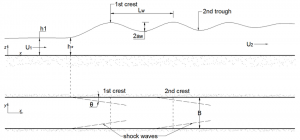Hydraulic jump
Hydraulic jump which is observed frequently flows the open channel such as spillways and rivers. The flow of water controls the fundamental objective of modern infrastructure from flooding rivers to canal irrigation, spillway of dams, and even stormwater drainage aqueducts facilitate. Hydraulic jump installs the open channel where the flow of water is unstable. flow becomes turbulent until a new depth attends downstream. although naturally arise often the hydraulic jump.
Types of hydraulic jumps: base of Froude’s number:
Hydraulics jump many types depending on surface roughness, topographical feature, and other interface relations.

Undular hydraulic jump.
It is not properly formed and there are water particles in certain turbulence. vegetation upstream and increases backwater rise by the increasing vegetation density and thickness. vegetation is produced by a breaking dissipated maximum energy and undular hydraulic jump. A non-breaking undular hydraulic jump was formed with intermediate vegetation on air bubbles.

Weak hydraulic jump.
Take the place of a weak jump when the velocity of water is very less and the water particle flows in various ways and is stable. The flow structure of a weak, turbulent hydraulic jump and the turbulent air-water interface is analyzed in detail using particle pic measurements of velocimetry. The study of hydraulic jump is motivated by the necessity to understand the detailed dynamics of turbulence generated by steady flow spilling breakers and breaker shear layer regions with attention to their topology and relative importance of reverse flow, mean flow, and turbulence structure.

Steady hydraulic jumps
The bed surface of steady hydraulic jumps is quite rough so the particle of water starts to tend in one direction with very heavy velocity and turbulence. When the Froude number falls into this limit, at the same location the jump forms steadily. With a steady hydraulic jump and turbulence confined within the jump, four major types of jumps and the location of the jump are the least susceptible to downstream flow conditions. Steady hydraulic jumps are generally the energy dissipation is usually considerable (45-70%) and well-balanced.

Oscillating hydraulic jump.
Forms of an oscillating hydraulic jump when oscillating jump jet enters into supper critical state and number of particles start to oscillate jump anticlockwise and clockwise direction and waves to the top surface or forming slighter tides.

Strong hydraulic jump.
It is a perfect jump formed when frictional losses are more and equal to air pressure division and velocity is high that losses take place.
Effect of Hydraulic Jump
The effect of hydraulic jump is widespread in the field of hydraulics to use hydraulic jump. Some effects of the hydraulic jump are as under: effect of hydraulic jump is used to perform different functions.
- Generally, the hydraulic jump usually acts as the energy of the dissipator. The effect of the hydraulic jump clears the surplus energy of water.
- Due to the hydraulic jump and many noticeable disturbances are created in the flowing water like reverse flow and eddies.
- Effect of a hydraulic jump when the hydraulic jump takes place and the considerable amount of air trapped in the water. Air can be helpful to remove the waste stream that is causing pollution in water flow.
- It also makes the work of different types of hydraulic structures, notches, and flumes, effective like weirs, etc.
Application of hydraulic jump.
- Generally, the use of hydraulic jump reverses the flow of water. The hydraulic jump can be used to mix chemicals for pure water.
- It usually maintains a high water level on the downstream side. It is used for high-level water for irrigation purposes.
- It can be used to remove the sewage lines to prevent air locking and air from a water supply.
- hydraulic jump prevents the scouring action dam structure on the downstream side.
